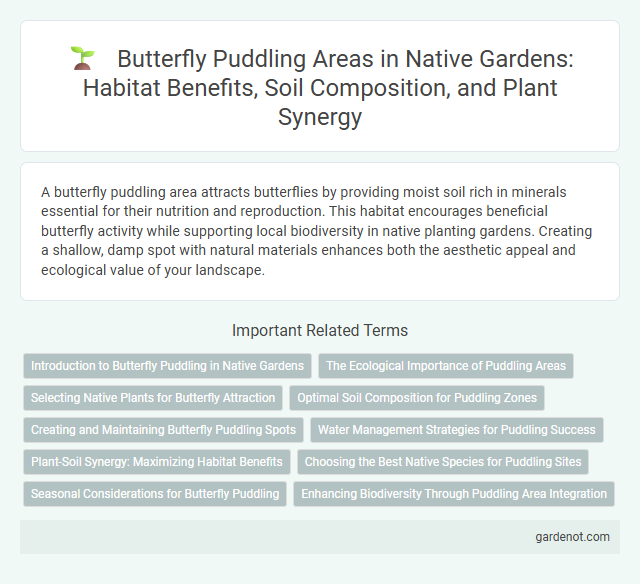A butterfly puddling area attracts butterflies by providing moist soil rich in minerals essential for their nutrition and reproduction. This habitat encourages beneficial butterfly activity while supporting local biodiversity in native planting gardens. Creating a shallow, damp spot with natural materials enhances both the aesthetic appeal and ecological value of your landscape.
Introduction to Butterfly Puddling in Native Gardens
Butterfly puddling areas in native gardens provide essential moisture and minerals that attract butterflies, promoting biodiversity and supporting local ecosystems. These specially designed damp patches with mineral-rich soil or sand offer vital nutrients like sodium and amino acids, which butterflies absorb to enhance reproduction and vitality. Incorporating puddling areas in native planting schemes encourages pollinator health and creates dynamic, sustainable habitats.
The Ecological Importance of Puddling Areas
Butterfly puddling areas serve as essential microhabitats where butterflies obtain vital minerals and nutrients, critical for reproduction and longevity. These moist, nutrient-rich patches support ecological balance by promoting pollinator health and enhancing biodiversity within native planting gardens. Establishing and preserving puddling zones fosters sustainable ecosystems by facilitating crucial nutrient cycling and supporting butterfly population stability.
Selecting Native Plants for Butterfly Attraction
Selecting native plants such as milkweed, coneflowers, and butterfly weed creates an ideal butterfly puddling area by providing essential nectar sources and moist soil for minerals. These plants support local butterfly species, enhancing biodiversity and promoting successful puddling behavior necessary for reproduction and vitality. Native flora also ensures environmental compatibility and reduces maintenance while attracting a wide variety of pollinators.
Optimal Soil Composition for Puddling Zones
Optimal soil composition for butterfly puddling zones includes a balanced mixture of sandy loam with high mineral content, particularly rich in calcium, magnesium, and sodium. These elements attract butterflies by providing essential nutrients required for reproduction and hydration. Maintaining slightly moist but well-drained soil enhances the puddling activity and supports native plant growth surrounding these areas.
Creating and Maintaining Butterfly Puddling Spots
Butterfly puddling areas are essential for providing butterflies with access to minerals and moisture critical for reproduction and survival. Creating these spots involves placing shallow depressions filled with moist soil, sand, or clay, often enriched with organic matter to attract butterflies. Regular maintenance includes keeping the area moist and free of debris to ensure it remains an inviting habitat for diverse butterfly species.
Water Management Strategies for Puddling Success
Water management strategies in butterfly puddling areas focus on maintaining shallow, moist soil that prevents waterlogging while ensuring continuous moisture for mineral absorption. Incorporating porous media and gentle slopes facilitates efficient drainage and prevents stagnation, promoting healthy butterfly activity. Regular monitoring of soil moisture levels aids in adjusting watering schedules to sustain optimal puddling conditions year-round.
Plant-Soil Synergy: Maximizing Habitat Benefits
Butterfly puddling areas enhance plant-soil synergy by promoting nutrient exchange between native plants and soil microorganisms, creating a thriving habitat for butterflies. Selecting native species with deep root systems improves soil aeration and moisture retention, fostering microbial activity crucial for nutrient cycling. This dynamic interaction supports butterfly populations while sustaining long-term ecosystem health.
Choosing the Best Native Species for Puddling Sites
Selecting native species for butterfly puddling areas enhances habitat suitability by providing essential minerals and moisture. Plants like milkweed (Asclepias spp.), Joe-Pye weed (Eutrochium purpureum), and ironweed (Vernonia spp.) support butterfly nutrition and encourage diverse pollinator activity. Incorporating species adapted to local soil and moisture conditions ensures sustainable puddling sites that attract and nourish native butterfly populations.
Seasonal Considerations for Butterfly Puddling
Butterfly puddling areas should be designed to accommodate seasonal fluctuations in moisture and temperature, ensuring availability during peak butterfly activity in spring and summer. Selecting native, mineral-rich soil and positioning puddling sites in sunny, sheltered locations enhances butterfly attraction and hydration. Maintaining puddling areas free from pesticides and periodically replenishing minerals supports sustained butterfly health and encourages year-round visitation.
Enhancing Biodiversity Through Puddling Area Integration
Butterfly puddling areas create essential microhabitats that attract various butterfly species, promoting pollination and supporting local ecosystems. Incorporating native plants with moist, sandy patches within these areas provides vital minerals and hydration, enhancing butterfly health and reproduction. Strategic integration of puddling sites in native planting designs fosters biodiversity by encouraging a diverse range of butterflies and other pollinators.
Butterfly puddling area Infographic

 gardenot.com
gardenot.com